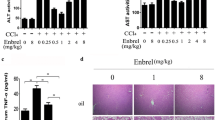Summary
Necrotic processes may be restricted to individual cell types of the liver or afflict several liver cells sequentially. Noxious agents may induce necrobiosis by different mechanisms of injury. In many instances, however, similar or identical terminal processes are involved, e.g. accumulation of Ca2+ in cytosol or mitochondria, termination of nucleic acid and protein syntheses or membrane damage. Apoptosis may also be a relevant feature of hepatic necrosis. Inhibition of mRNA synthesis and posttranslational glycosylations of proteins of the hepatocytes is instrumental in D-galactosamine-induced hepatocellular necrosis. An early event seen after administration of D-galactosamine plus endotoxin is an accumulation of neutrophilic granulocytes in the liver sinusoids. It results from the tumor necrosis factor (TNF)-α-induced adhesion of polymorphonuclear leukocytes to the sinusoidal endothelium and the vasoconstriction due to thromboxane A2 that is secreted by activated Kupffer cells. Temporal hypoxia and nutrient deprivation as well as the activation of the granulocytes with release of reactive oxygen species and proteinases appear to be severe consequences. Hypoxia followed by reperfusion (reoxygenation) must be considered as a mechanism of liver cell necrosis producing reactive oxygen species; oxygen radicals were reported to be signals for the activation of nuclear factor χB and thereby for the cytotoxicity of cytokines.
Similar content being viewed by others
References
Popper H. Introduction. In: Keppler D, Popper H, Bianchi L, Reutter W, eds. Mechanisms of Hepatocyte Injury and Death. Lancaster: MTP Press, 1984;l-10.
Farber E. Biochemical pathology. Annu Rev Pharmacol 1971;11: 71–96.
Decker K, Keppler D. Galactosamine-induced liver injury. In: Popper H, Schaffner F, eds. Progress in Liver Diseases (IV). New York: Grune & Stratton, 1972;183–199.
Decker K, Keppler D. Galactosamine Hepatitis. A key role of the nucleotide deficiency period in the pathogenesis of cell injury and cell death. Rev Physiol Biochem Pharmacol 1974;71:77–106.
Galanos C, Freudenberg MA, Reutter W. Galactosamine-induced sensitization to the lethal effects of endotoxin. Proc Natl Acad Sci USA 1979;76:5939–5943.
Trevisan A, Realdi G, Alberti A, et al. Core antigen specific immunoglobulin G bound to the liver cell membrane in chronic hepatitis B. Gastroenterology 1982;82:218–222.
Chisari FV. Hepatitis B virus gene expression in transgenic mice. Mol Biol Med 1989;6:143–149.
Heinemeyer W, Kleinschmidt JA, Saidowsky J et al. Proteinase yscE, the yeast multicatalytic/multifunctional proteinase: mutants unravel its function in stress-induced proteolysis and uncover its necessity for cell survival. EMBO J 1991;10:555–562.
Craig EA. Essential roles of 70 kDa heat-inducible proteins. Bioessays 1989; 11:48–52.
Ji S, Lemasters JL, Christenons V, et al. Periportal and pericentral pyridine nucleotide fluorescence from the surface of the perfused liver: evaluation of the hypothesis that chronic treatment with ethanol produces pericentral hypoxia. Proc Natl Acad Sci USA 1982;79:5415–5419.
Compton MM, Cidlowsky JA. Thymocyte apoptosis: a model of programmed cell death. Trends Endocrinol Metab 1992;3:17–23.
Bellomo G, Jewell SA, Smith MT, et al. Perturbation of Ca2+ homeostasis during hepatocyte injury. In: Keppler D, Popper H, Bianchi L, Reutter W, eds. Mechanisms of Hepatocyte Injury and Death. USA: MTP, 1984;119–128.
Parke DV, Ioannides C. Reactive intermediates and oxygen toxicity in liver injury. In: Keppler D, Popper H, Bianchi L, Reutter W, eds. Mechanisms of Hepatocyte Injury and Death. USA: MTP, 1984;37–48.
Schreck R, Meier B, Männel DN, et al. Dithiocarbamates as potent inhibitors of nuclear factorxB activation in intact cells. J Exp Med 1992;175: in press.
Brouwer A, Barelds R, Knook DL. In: Rickwood D, ed. Centrifugation, a practical approach. Oxford: IRL Press, 1984;183–218.
Eyhorn S, Schlayer HJ, Henninger HP, et al. Rat hepatic sinusoidal endothelial cells in monolayer culture. Bio-chemical and histological characteristics. J Hepatol 1988;6:23–35.
Tran-Thi TA, Gyufko K, Reinke M, et al. Output and effects of thromboxane produced by the liver perfused with phorbol myristate acetate. Biol Chem Hoppe-Seyler 1988;369:1179–1184.
Tran-Thi TA, Gyufko K, Henninger HP, et al. Studies on synthesis and degradation of eicosanoids by rat hepatocytes in primary culture. J Hepatol 1987;5:322–331.
Zacharchuk CM, Drysdale BE, Mayer MM, et al. Macrophagemediated cytotoxicity: role of a soluble macrophage cytotoxic factor similar to lymphotoxin and tumor necrosis factor. Proc Natl Acad Sci USA 1983;80:6341–6345.
Aggarwal BB, Kohr WJ, Hass PE. Human tumor necrosis factor. Production, purification and characterization. J Biol Chem 1985; 260:2345–2354.
Gaillard T, Mülsch A, Busse R, et al. Regulation of nitric oxide production by stimulated rat Kupffer cells. Patho-biology 1991;59: 280–283.
Schlayer HJ, Laaf H, Peters T, et al. Involvement of tumor necrosis factor in endotoxin-triggered neutrophil adherence to sinusoidal endothelial cells of mouse liver and its mo-dulation in acute phase. J Hepatol 1988;7:239–249.
Tran-Thi TA, Busam K, Gaillard T, et al. Effects of hypoxia on hepatic metabolism of prostanoids. In: Wisse E, Knook DL, McCuskey R, eds. Cells of the Hepatic Sinusoid, Vol. 3. Rijswijk: Kupffer Cell Foundation, 1991;395–397.
Keppler D, Lesch R, Reutter W, et al. Experimental hepatitis induced by D-galactosamine. Exp Mol Pathol 1968;9:279–290.
Tran-Thi TA, Phillips J, Falk H, et al. Toxicity of D-galactosamine for rat hepatocytes in monolayer cultures. Exp Mol Pathol 1985; 42:89–116.
Decker K. Biologically active products of stimulated liver macrophages (Kupffer cells). Eur J Biochem 1990;192:245–261.
Dinarello CA. The proinflammatory cytokines interleukin-1 and tumor necrosis factor and treatment of the septic shock syndrome. J Infect Dis 1991;163:1177–1184.
Schlayer HJ, Karck U, Ganter U, et al. Enhancement of neutrophil adherence to isolated rat liver sinusoidal endothelial cells by supernatants of lipopolysaccharide-activated monocytes—role of tumor necrosis factor. J Hepatol 1987;5:311–321.
Wake K, Motomatsu K, Ekataksin W. Postnatal development of the perisinusoidal stellate cells in the rat liver. In: Wisse E, Knook DL, McCuskey RS, eds. Cells of the Hepatic Sinusoid, Vol. 3. Rijswijk: Kupffer Cell Foundation, 1991;269–275.
Author information
Authors and Affiliations
Additional information
The work performed in the author’s laboratory was supported by grants from Deutsche Forschungsgemeinschaft, Bonn, and Fonds der Chemischen Industrie, Frankfurt/M, Germany
Rights and permissions
About this article
Cite this article
Decker, K. Mechanisms and mediators in hepatic necrosis. Gastroenterol Jpn 28 (Suppl 4), 20–25 (1993). https://doi.org/10.1007/BF02782883
Issue Date:
DOI: https://doi.org/10.1007/BF02782883




